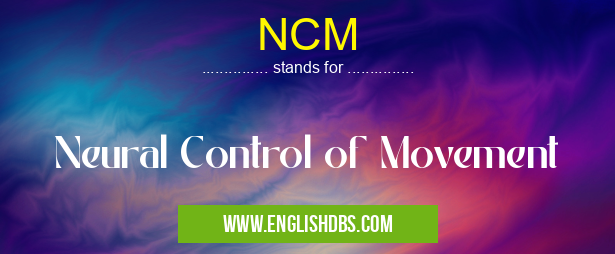What does NCM mean in PHYSIOLOGY
NCM (Neural Control of Movement) is a process by which the brain, nervous system and muscles work together to produce precise coordinated movements. It is essential for activities such as walking, speaking and other daily activities. In medical terms, NCM refers to an understanding of how the structures of the nervous system control movement such as posture, locomotion, fine motor skills, balance and coordination. This understanding helps in diagnosis and treatment of diseases related to impaired mobility.

NCM meaning in Physiology in Medical
NCM mostly used in an acronym Physiology in Category Medical that means Neural Control of Movement
Shorthand: NCM,
Full Form: Neural Control of Movement
For more information of "Neural Control of Movement", see the section below.
» Medical » Physiology
Essential Questions and Answers on Neural Control of Movement in "MEDICAL»PHYSIOLOGY"
What is Neural Control of Movement (NCM)?
Neural control of movement (NCM) is the process by which the nervous system coordinates and controls the various muscle contractions that are needed for physical movement. NCM involves both voluntary and involuntary muscular responses to sensory information and is influenced by external environmental factors. The ultimate goal of NCM is to maintain homeostasis, posture, posture changes, stability, efficiency, speed, accuracy and dexterity with every movement.
What components are involved in NCM?
The components involved in NCM consist of sensory neurons, motor neurons, muscles and the brain. Sensory neurons provide information from the environment to the central nervous system so that it can respond accordingly. Motor neurons send signals from the brain or spinal cord to the muscles responsible for creating movement. Muscles contract from these signals resulting in physical movement. Finally, the brain acts as a control center, integrating all of this information and sending out new signals as needed.
How does NCM work?
When an individual wishes to move a body part such as his arm or his leg, signals are sent from his brain down nerves to his muscles telling them what action they need to perform. Once these signals reach their intended destination – a motor neuron associated with a specific muscle group – they travel across its surface membrane causing it to release neurotransmitters. These neurotransmitters then attach themselves to receptor sites on interested muscle fibers triggering them into action and resulting in physical movement.
How does sensory information affect NCM?
Sensory input plays an important role in Neural Control of Movement (NCM). It helps inform our bodies about the external environment so that appropriate responses may be made through muscular activity. Sensory input can include visual cues such as objects or moving images that require us to adjust our movements accordingly; tactile sensations like pressure or temperature that warrant precision movements; or proprioceptive feedback which informs us of the position of our limbs relative to one another which allows us for coordinated activities such as walking.
What areas of research focus on NCM?
Research involving neural control of movement focuses on better understanding how our nervous systems coordinate dynamic behavior within ourselves and/or our environment in order to achieve desired outcomes such as balance and efficiency during physical activities like running or cycling. This field has also seen increasing attention due to emerging technologies such as robotics where having accurate predictive models for motion control have been essential for successful development of semi-autonomous machines.
What are some diseases related with irregularities in NCM?
Diseases related with irregularities in neural control of movement range from mild impairments such as clumsiness or difficulty with coordination tasks to more serious conditions like spasticity caused by damage either within the nervous system itself or outside influences such as environmental toxins or trauma-related injuries leading up paralysis.
How can injury affect neural control of Movement?
Injury can directly lead up impairments within a person’s neural pathways leading up difficulties with coordination tasks that would otherwise be automatic movements requiring minimal thought processes. Injuries may also cause physical abnormalities which lead up compensations due adjustment within existing coordinate systems.
Final Words:
In conclusion, Neural Control Of Movement (NCM) plays an important role in enabling humans to carry out everyday activities like talking, walking and writing with precise coordination. Understanding how this process works has enabled us to better diagnose musculoskeletal issues stemming from disturbances in neurology and provide more effective intervention strategies through targeted pharmacology or rehabilitation programs that restore normal functioning capabilities in those affected by serious neurological disorders like Parkinson’s disease or stroke impairments.
NCM also stands for: |
|
| All stands for NCM |
